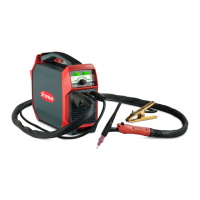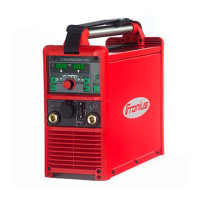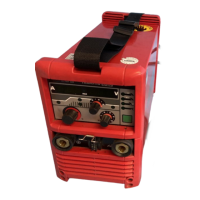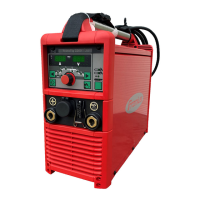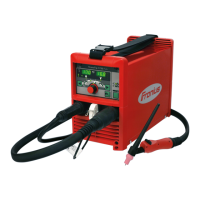69
DIGITAL AMMETER A
This indicator enables very precise adjustments to be made
for the start arc, main current and crater-fill current.
The current command values can be read off even when the
welder is running through the switching sequence while the
machine is still in open circuit.
Command value --> required welding current
Actual value --> actual welding current
The command values and the actual values are compared
internally by the electronic regulator.
HF-SELECTEUR D'AMORÇAGE D'ARC ELECTRIQUE TIG
Sert à la présélection de la variante d'amorcage désirée lors
du soudage TIG C.C.
Position du sélecteur 1
L'amorçage de l'arc électrique se fait par haute fréquence
(HF) aprés l'appui sur la gâchette du pistolet
(sans contact avec la pièce à travailler)
HF déconnecte automatiquement après l'amorçage
Application: Quand des marques d'amorçage ou les moindres
inclusions de tungstène ne sont pas admises
Switch position 0
The arc is ignited on contact between the tungsten electrode
and the workpiece after the torch trigger has been pressed.
The short-circuit current that flows when the electrode
touches the workpiece corresponds to the start-arc current
I
s
has been set.
Set the start arc with dial so as to obtain an amperage of
around 15A on workpiece contact (N.B. the value will be a
percentage of the main current I
H
).
IMPORTANT! If the start-arc current is set too high, the tip of
the tungsten electrode will be overloaded during the short-
circuit phase. (Will "stick" to the workpiece - i.e. tungsten
inclusions at the point of ignition). If the start-arc current is set
too low, i.e. below 10A, the tip of the tungsten electrode cannot
heat up sufficiently during the short-circuit phase. The arc will
thus tend to break once the electrode is lifted off the surface
of the workpiece.
Used: Wherever HF ignition would cause external interference.
(See description: EXTERNAL INTERFERENCE on p. 34)
FREQUENCY RANGE SWITCH f[HZ]
This is for preselecting the desired frequency range for TIG
pulsed-arc welding in conjunction with remote-control unit
TR 50-1.
SETTING DIAL for preselecting the **IGNITION CURRENT
for *"Soft Start" ignition (not fitted as standard)
Soft Start ignition - description
For contact ignition to take place, there must be physical
contact between the tungsten electrode and the workpiece.
When this occurs, there is an increased short-circuit current
flow which normally causes damage to the tip of the electrode.
In "Soft Start" ignition, the short-circuit current is prevented
from rising beyond the limit set on the electronic regulator, and
no damage is done to the tip of the tungsten electrode. In order
for an arc to be produced and maintained when the electrode
is lifted off the surface of the workpiece, the ignition current
may not fall below a certain value. The rule here is: the wider
the electrode diameter, the higher the ignition current must be
(otherwise the arc will go out when the electrode is lifted off the
workpiece). The printed scale showing values for various
diameters of tungsten electrode from 1 - 4.0 mm will help you
to set the correct ignition current. The arc current given for
each diameter of electrode will result in optimum ignition with
this electrode - provided that the electrode is in normal
condition.
* "Soft-start" ignition = soft contact ignition
** Arc current when electrode is lifted off workpiece
LED INDICATOR for TIG pulsed arc operation
lights up when TR 50-1 pulsed-arc remote control unit is
used
LED INDICATOR for TIG spot welding
lights up when TR 51 spot-welding remote control unit is
connected
GAS PRE-FLOW TIME
For continuous adjustment of the gas pre-flow time from
0,2 to 2 seconds (N. B. the longer the torch hose-pack,
the longer the gas pre-flow time must be)
START ARC: I
s
Functions: a. =Ignition current in the and
spot-welding modes
b. =Short-circuit current for TIG welding with
contact ignition
c. = Start arc only in the
modes
Start arc is set as a %age of the main current as standard
Start arc may also be set as an absolute value. For this, the
"%/Abs." slide switch on the ETC 2A pc board must first be
switched over (see Fig. 46)
Start arc ignition is initiated via the torch trigger, and is in-
dicated by the control lamp . (Indication is not dependent
on current-flow !)
The digital ammeter indicates the command value for the
current even while the machine is still in open circuit.
UP-SLOPE or current rise time
For continuous adjustment of the current rise speed from
the start arc up to the main current I
H
Range: 0,2 to 7 seconds (I min. - I max.)
MAIN CURRENT DIAL I
H
--> welding current
Welding current is steplessly adjustable from 3 to 330 /
3 to 450A
affichage DEL allumé
l'ampèremetre numérique indique la valeur de couranr déja
en marche à vide
DOWN-SLOPE or current drop time
For continuous adjustment of the current drop speed from
the main current down to the crater-fill current I
E
Range: 0,2 to 7 seconds (I max. - I min.)
FINAL CRATER CURRENT I
E
Only possible in the 4-step operating mode.
Final crater current is set as a %age of the main current as
standard.
Like the start arc, the final crater current may also be set as
an absolute value. For this, the "%/Abs." slide switch on the
ETC 2A pc board must first be switched over (see Fig. 46)
The welding current drop (i. e. down to the final crater
current) is initiated via the torch trigger, and is indicated by
the control lamp
.
The digital ammeter indicates the command value for the
current even while the machine is still in open circuit.
GAS POST-FLOW TIME
Continuous adjustment range from 2 - 26 secs.
The gas post-flow time will depend on the diameter of the
tungsten electrode being used, and on the welding current
amperage. The flow of gas prevents any oxydation of the
end crater or of the tungsten electrode. If the gas post-flow
has been set too short, there will be discolouration of the
tungsten electrode, leading to undesirable oxide inclusions
and contamination of the welding pool when an arc is next
ignited.
Please note: The gas post-flow can only be activated after
the end of an actual welding sequence - it will not function
when the welder is running through the switching sequence
with the machine in open circuit.
